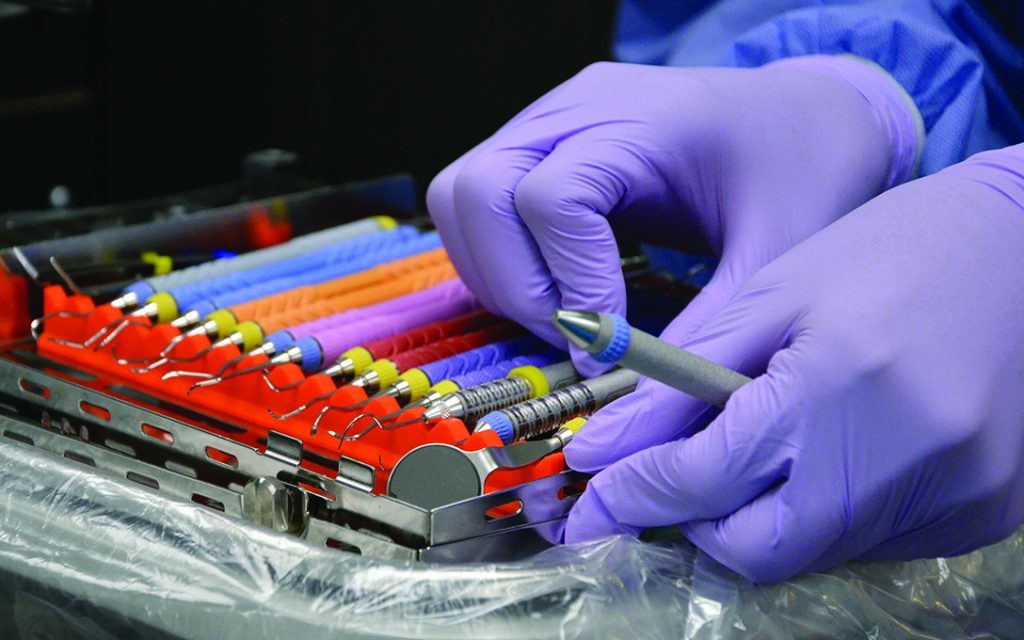
Written by Jackie Denton, originally published at uthsc.edu
Can a candy be good for your teeth? It can be, with the right ingredients.
Researchers from the College of Dentistry and the College of Pharmacy at the University of Tennessee Health Science Center have worked together to develop a lollipop that is changing the way erosion of tooth enamel is treated.
Searching for Options
The idea to create a preventive product to protect tooth enamel didn’t start off as a lollipop, but with something more commonly associated with oral health – a mouthwash.
“Early in my career I was exposed to a young patient who suffered from an eating disorder for several years,” said Mojdeh Dehghan, DDS, chair of the UTHSC College of Dentistry’s Department of General Dentistry, and the patent co-inventor for the lollipop. “There was a lot of destruction to the structure in her mouth. She had a lot of erosion on her anterior teeth and she was very embarrassed when she smiled.”
The patient was also in a lot of pain.
Sixteen crowns and veneers later, Dr. Dehghan had restored her patient’s smile. After the experience, she knew there had to be something dentists could do to help patients suffering from enamel erosion due to overexposure from acids.
“That was the first time I was exposed with this much tooth structure destruction and with someone so young,” she said. “Eating disorders have this negative stigma associated with them, so she was very shy and hesitant to really share her story with a dentist. I was really curious as to what dentists and the dental profession can do for this patient population.”
Dental treatment for bulimic patients sometimes required extensive and expensive dental work to repair the damage caused from self-induced vomiting or purging. So, Dr. Dehghan began looking for products that could work as a preventive measure for enamel erosion.

Developing the Product
“At the time, this is like almost 30 years ago, there wasn’t a protocol for treating patients that had recurrent acidic episodes,” Dr. Dehghan said.
After joining the faculty of the UTHSC College of Dentistry in 2011, Dr. Dehghan met a faculty member who had done extensive research on patients with acid reflux. Here was an ideal partner to begin developing the product she looked for years ago.
Teaming up with Daranee Versluis, DDS, PhD, director of biomaterials and a professor in the Department of General Dentistry, the pair developed a two-step mouthwash that would neutralize acidity in the mouth, while hardening tooth enamel that had been softened from overexposure to stomach acids or everyday liquids, such as coffee, juices, and carbonated beverages.
Soon, they realized their mouthwash could help not only patients who suffered from eating disorders, but patients who experience enamel erosion from acid reflux disease, pregnant women who suffer from morning sickness, and cancer patients undergoing chemotherapy.
“We looked at the products that were out in the market and felt like there’s really nothing out there that’s designated for that population, and came out with our own version of something that would work for this patient population,” Dr. Dehghan said.
In 2015, she received a Proctor and Gamble/Gillette Hayden Memorial Foundation Research Award from the American Association of Women Dentists for a $10,000 grant to begin a pilot clinical study with a rehabilitation and treatment center in Cordova for patients suffering from eating disorders. She partnered with psychiatrists, nutritionists, and nurses there.
The clinical study led to the realization that a two-step mouthwash was difficult for patients to use throughout the day.
They needed to create something that would be accessible and easy to carry.

Changing the Formula
After receiving a grant from the University of Tennessee Research Foundation (UTRF) Maturation Fund in 2016, Dr. Dehghan asked Dr. Hassan Almoazen, PhD, director of the PhD program in pharmaceutical sciences at UTHSC, to help with combining the two solutions into one. From a basic chemistry point of view, this was impossible, since some minerals needed to be in an acidic, solution while other minerals needed to be in a basic solution.
“I proposed instead of having two solutions, we can flip the system into a solid,” said Dr. Almoazen, who has partnered with other colleges on campus on multiple product developments and clinical trials. “We can make a lollipop or lozenge with multilayers, one that releases ions and raises the pH of saliva (an external layer), and the other layer (an internal layer) with other ingredients such as the proteins that can help the remineralization process of the teeth.”
Dr. Almoazen spent four months developing the product from a solution into a solid, with the help of a student working in his lab at the time and who is now enrolled in the College of Dentistry.
They developed the lollipop, which has multiple layers, with each layer serving a different function. The salivary glands aid in neutralizing the acid, hardening the enamel. The solid formulation is not only portable, but also allows the product to stay in the mouth much longer than a mouthwash. With the addition of a stick, the product became a lollipop.
But the journey from liquid to a solid wasn’t without roadblocks.
“The mouthwash is something you spit out of your mouth, so the FDA (Food and Drug Administration) is not as particular about that,” Dr. Dehghan said. “But the lollipop or lozenge formulation is something people are ingesting, so we had to go through a lot of safety regulations and audits to make sure that what we’re introducing to the market is safe for adults and even small children. The philosophy for our product development was to create something natural and safe.”
“This system can be commercialized as a product that doesn’t need a prescription,” Dr. Almoazen said. “You can put it into different pharmacies. All the ingredients are safe, there is no drug. This will have a huge impact on dental care. It can be scaled up or down for adults or children. There’s no sugar in it. It can help remineralize teeth and help prevent cavities. For kids who love lollipops, this product can steer them away from sugar-based lollipops, of course they can’t use more than one or two a day, because it is not a true candy.”
After the team conducted clinical trials on the new formulation, mango emerged as the preferred flavor for the product.
UTRF helped file the patent and offered guidance on how to successfully get the product to consumers. Patent in hand, the three coinventors are now working with different companies to best market the product.
“For everyone at UTRF, supporting researchers like Drs. Dehghan, Versluis, and Almoazen as they work to translate an idea into a product is exciting and rewarding,” said Richard Magid, PhD, UTRF vice president. “By supporting innovations, we ensure that patients continually have more and better available treatment options.”
Hitting the Market
The team hopes that the lollipop and lozenge will be available in 2020 for individuals through their local dentist or retail store. “Our hope and vision is that if somebody is suffering from an eating disorder and is not willing to confide to their dentist, they can go to the pharmacy or a retail store and purchase the product in private, and start benefiting from it,” Dr. Dehghan said.
“Even if we have obstacles hitting the market, we already know that we’ve made some impact in our profession because of awareness through articles we’ve published and courses we’ve given,” Dr. Dehghan said. “We feel like we’ve had a little part in bringing more awareness to how to deal with patients with eating disorders and how to slow the progression, destruction, and erosion of tooth enamel.”
Tags: College of Medicine, College of Pharmacy, Featured, UT Health Science Center, UT Research Foundation